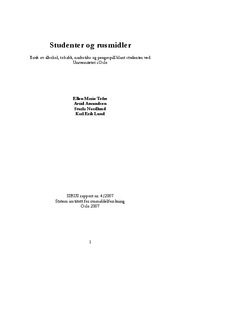| dc.contributor.author | Tefre, Ellen Marie | |
| dc.contributor.author | Amundsen, Arvid | |
| dc.contributor.author | Nordlund, Sturla Bjørn | |
| dc.contributor.author | Lund, Karl Erik | |
| dc.date.accessioned | 2015-01-29T14:15:36Z | |
| dc.date.accessioned | 2015-02-11T18:37:30Z | |
| dc.date.available | 2015-01-29T14:15:36Z | |
| dc.date.available | 2015-02-11T18:37:30Z | |
| dc.date.issued | 2007 | |
| dc.identifier.citation | SIRUS-rapport. 130 p. SIRUS, 2007 | |
| dc.identifier.isbn | 978-82-7171-302-7 | |
| dc.identifier.uri | http://hdl.handle.net/11250/275857 | |
| dc.description | - | |
| dc.description.abstract | Denne rapporten presenterer resultatene av prosjektet
Studenter og Rus.
I 2006 deltok 1655 studenter ved Universitetet i Oslo i en
spørreskjemaundersøkelse om bruk av
alkohol og andre rusmidler, røyking
og pengespill. Resultatene er sammenlignet med funn fra en tilsvarende
studentundersøkelse i 1997.
Det store flertallet av studentene (vel
95 prosent) hadde drukket alkohol
siste år. Kvinnene hadde i gjennomsnitt
drukket 5 liter ren alkohol siste år,
og mennene hadde drukket nesten d
obbelt så mye; 9 liter. En av sju
kvinner (14 prosent) og en av tre
menn (34 prosent) hadde drukket mer
enn 10 liter ren alkohol siste år. Dette
tilsvarer et inntak på 8-9 halvlitere
med øl, eller vel to flasker vin hver
eneste uke i ett år. Unge voksne er den
befolkningsgruppen som drikker mest, og studentene drikker minst like
mye som andre i samme aldersgruppe.
I likhet med hva vi har sett i den gene
relle befolkningen, har det vært en
klar økning i alkoholkonsumet blant st
udenter (20 prosent), og kvinnene
har økt mest (28 prosent). Økningen
er først og fremst knyttet til høyere
alkoholinntak i hver drikkesituasjon, me
ns antall ganger de drikker, ikke er
vesentlig endret. Når studenter drikke
r, er alkoholinntaket ofte høyt; menn
drikker seks alkoholenheter (tilsvarende
4 halvlitere øl eller seks glass vin),
eller mer i nesten halvparten av drik
ketilfellene, mens kvinner drikker så
mye i vel en fjerdedel av gangene de
drikker. Single mannlige studenter
som bor i egen bolig eller kollektiv,
er de som drikker mest. Gifte eller
samboende kvinnelige studenter med barn, drikker minst.
Det høye alkoholkonsumet gjenspeiles og
så i omfanget av alkoholrelaterte
skader. Mer enn en tredjedel av studentene hadde et drikkemønster som
innebærer en høy eller alvorlig risiko for skader. Mange rapporterte om
ulike negative konsekvenser av alkoho
lkonsumet sitt; i løpet av studietiden
hadde halvparten skulket undervisning, en tredjedel hadde hatt ’blackouts’,
en fjerdedel hadde hatt ubeskyttet sex, en av ti hadde vært utsatt for skader
eller ulykker, en av tre hadde vært innblandet i krangel og ca fem prosent
hadde vært innblandet i slåsskamp. Som forventet var omfanget av
alkoholrelaterte skader klart høyere blant menn, enn blant kvinner. Til
tross for økning i alkoholkonsum, viste ingen av studentenes
selvrapporterte negative konsekvenser øk
ning fra 1997 til 2006. Endringe | |
| dc.description.abstract | This report presents the results of the project Students’ Use of Alcohol and Drugs. In 2006, 1655 students at the University of Oslo took part in a questionnaire survey on the use of alcohol and other intoxicants, smoking and gambling. The results were compared with the findings from a corresponding student survey in 1997.
The vast majority of the students (some 95 per cent) had consumed alcohol in the past year. On average, the women had consumed five litres of pure alcohol in the past year, while the men had drunk nearly twice that amount, i.e. nine litres. One of seven women (14 per cent) and one of three men (34 per cent) had consumed more than 10 litres of pure alcohol in the past year. This corresponds to an intake of eight to nine half litres of beer or some two bottles of wine every single week for a year. Young adults are the demographic group that drinks most, and the students drink at least as much as others in the same age group.
As observed among the general public, there has been a clear increase in alcohol consumption among students (20 per cent), and women have demonstrated the steepest increase (28 per cent). The increase is first and foremost related to a higher intake of alcohol in each drinking situation, while the number of times they drink has not changed significantly. When students drink, their intake of alcohol is often high; men drink six alcohol units (comparable to four half litres of beer or six glasses of wine) or more in nearly half the drinking incidents, while women drink that much more than every fourth time they drink. Single male students who live in their own dwelling or in a collective, drink the most. Married or cohabiting female students with children drink the least.
High alcohol consumption is also reflected in the scope of alcohol-related injuries. More than one-third of the students exhibited a drinking pattern entailing a high or serious risk of injury. Many reported a variety of negative consequences from their alcohol consumption. During their time at university, half had cut class, one-third had had ’blackouts’, one-fourth had had unsafe sex, one-tenth had suffered injuries or accidents, one of three had been in an argument and approx. five per cent had been involved in a fight. As expected, the scope of alcohol-related injuries was distinctly higher among men than women. Despite the increase in alcohol consumption, none of the students’ self-reported adverse consequences showed any increase from 1997 to 2006. Possible explanations include changes in the sample of students and a generally higher tolerance for intoxication, as well as a larger spread in consumption among the students. | |
| dc.language.iso | nor | |
| dc.relation.uri | http://www.sirus.no/filestore/Import_vedlegg/sirusrap.4.07.pdf | |
| dc.title | Studenter og rusmidler. Bruk av alkohol, tobakk, narkotika og pengespill blant studenter ved Universitet i Oslo | |
| dc.title.alternative | Students`Use of Alcohol and Drugs | |
| dc.type | Research report | |
| dc.date.updated | 2015-01-29T14:15:35Z | |
| dc.identifier.cristin | 1012073 | |
